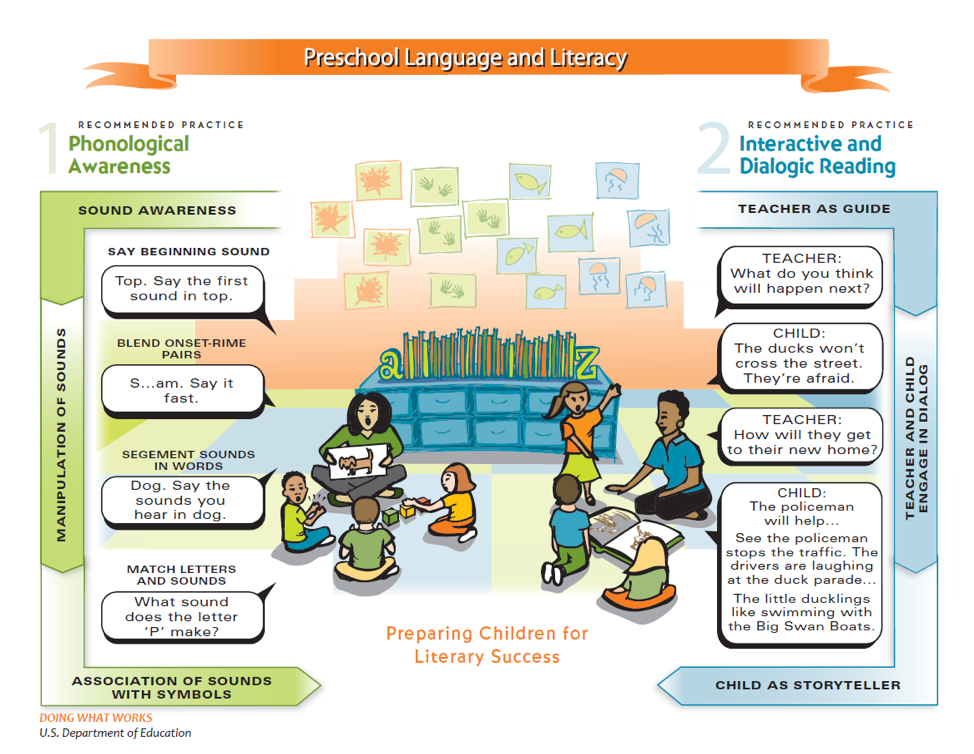What should literacy instruction look like in a preschool classroom? As high-stakes testing puts more pressure on teachers and students, the spotlight is shifting to evaluate how we are preparing students in the years before kindergarten. Expectations for our early learners are going up. Many districts are struggling with how to help more children enter kindergarten ready and on a path to academic success. While it may be tempting to transform preschool classrooms to look more like kindergarten, the research shows that there are two literacy strategies that are proven to be developmentally appropriate and massively impactful for future reading success.
This graphic from the U.S. Department of Education illustrates these two practices in action. Based on the findings of What Works Clearinghouse, phonological awareness training and interactive and dialogic reading are effective strategies to put preschoolers on the path to reading success.

Why Teach Phonological Awareness in Preschool?
When a child enters preschool, their brain has spent the last 3-4 years working to make meaning out of all the sounds people make when we talk. The skill of understanding spoken language develops naturally. At birth, babies can hear all the sounds humans make--no matter which language. But as a baby’s brain develops, it naturally narrows its awareness to the sounds in the language spoken at home. And then babies transition from hearing sounds to making meaning from those sounds. From about 18 months of age up, a child’s brain is focused on making meaning out of chunks of sounds. By age 4, children have been so focused on communicating that they lose awareness of the individual sounds in words.
But reading and spelling in English require awareness of sounds. English (and many other languages) use an alphabetic writing system in which written letters represent spoken sounds. When a child is not aware of the sounds in language, they are likely to be mystified by the print system and how it works. A child needs to hear the /d/ sound at the beginning of “dog” in order to understand the logic of why that word “dog” starts with letter d.
People often think that reading instruction begins with learning about the alphabet. But children need to get ready to read long before they understand that letters stand for sounds. Reading instruction actually starts when children begin tuning in to the sounds of spoken words. Preschool is a perfect time to develop this awareness.
How Footsteps2Brilliance Creates Phonological Awareness in Preschool Children
Phonological awareness is made up of a group of skills that progress in challenge. At first, children are able to distinguish chunks of sounds. For example, they can learn to identify words that rhyme. Children can also break words apart by clapping or counting the “beats” (syllables). For these skills, phonological awareness progresses from noticing to doing. After children recognize rhyming words, they start to invent rhymes on their own.
Nursery rhymes and chants are an important tool to help build a child’s awareness of sounds in language. Nursery rhymes provide opportunities to hear rhymes, alliteration, and rhythm in language. In fact, learning nursery rhymes has been found by research to enhance phonological awareness and stimulate reading development (Harper, 2011.)
Traditional English and Spanish nursery rhymes are at the heart of the early reading instruction in Footsteps2Brilliance and Clever Kids University. Children sing along to and play with a nursery rhyme each week. They also play rhyming games and other activities to develop their awareness of sounds. Best of all, because the program is 100% bilingual in English and Spanish, children are encouraged to develop these skills in their home language. And because a child’s phonological awareness skills apply to other languages, children can easily apply their knowledge in a dual language setting.
Why Use Interactive and Dialogic Reading?
Learning the mechanics of reading is not enough to ensure reading proficiency and success on high-stakes reading tests. It is not enough to know how to sound out words. The purpose of reading is understanding. Many programs that focus heavily on decoding and phonics still find that their students are struggling readers when they arrive in third grade.
A successful reader needs both strong phonological awareness and strong oral language. Oral language is often associated with vocabulary. However, in the broadest definition, oral language consists of all of the ways we make meaning out of language, including semantics, sentence structure, grammar, and story structure. These skills are best developed through frequent experiences reading and exploring books. Unfortunately, there is a huge disparity in the quantity and quality of reading children experience at home before entering school. While some children enter school with thousands of hours of experience with books, other children enter school with fewer than 25 hours of shared book reading. This language deficiency may not be obvious at first, but without intervention, children are likely to fall further and further behind.
The most effective way to accelerate language development is interactive and dialogic reading. This research-based early literacy strategy has been demonstrated to help children jump ahead by months in only a few weeks of dialogic reading. Underlying the strategy is the understanding that how we read to preschoolers is as important as how frequently we read to them.
Dialogic reading actively engages children in books. With repeated readings of the book, the adult transitions the storytelling to the child through prompts and questions. Children are encouraged to make observations, use new vocabulary, and to follow their own interests. At its heart, dialogic reading is just children and adults having a conversation about a picture book.
Interactive, engaging eBooks in Footsteps2Brilliance and Clever Kids University provide wonderful literature for dialogic reading. Built-in animations and karaoke recording features naturally encourage children to become active participants in the storytelling. Parents and teachers often observe that children are anxious to show what they know in this fun digital environment.




